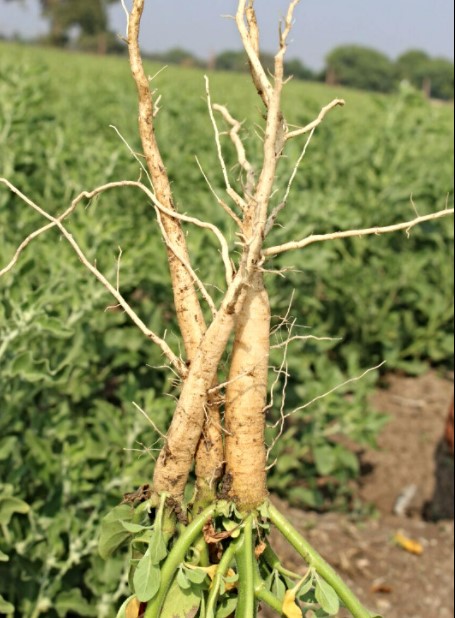
Ashwagandha is an evergreen shrub that grows primarily in Asia and Africa. It is commonly used to treat stress. There is little evidence that it is effective as an “adaptogen.”
This herb can also lower blood pressure, reduce swelling, and calm the brain in addition to enhancing the immune system.
An Ashwagandha plant grows from 35 to 75 cm (14 to 30 in) tall. Leaflets of Ashwagandha are dull green, elliptical, and about 10–12 cm (3.9–4.7 in) long. Flowers appear on the plant in the form of small, green bells. Fruits of this plant are orange-red when ripe.
VERNACULAR APPEARANCES BY NAMES:
Ashwagandha’s species name means “sleep-inducing” in Latin. Another name for it is Winter Cherry.
The Sanskrit word ashwagandha, which combines the words “ashva” and “gandha,” was used to describe this root, because it smells strongly of horses.
There are various names for it in other Indian languages, including:
- Hindi – Ashgandh
- Kannada – Amangura
- Malyalam – Amukurram
- Marathi – Askandh
- Tamil – Achuvagandi
TYPE OF CROP:
Indian Kharif Crops include Ashwagandha. Propagation of this plant is done either by seed in spring or by greenwood cuttings in autumn.

A subtropical climate is ideal for Ashwagandha. Crops such as this can be grown in semitropical areas with rainfall of 300-350 mm. During the growing season, the crop requires a dry season. Ideally, the cultivation of this plant should take place at temperatures from 20° C to 35° C.
THE CULTURE OF:
Dry stony soil is best for Ashwagandha in a sun to partial shade location. Rajasthan, Haryana, Gujarat, Maharashtra, and Madhya Pradesh are drier regions of India where this plant grows.
In countries other than India, it is mostly grown in Nepal, Sri Lanka, China, and Yemen.
PREPARE THE FIELD:
A good soil pH is just below 8.0, with excellent drainage, and ashwagandha thrives in sandy loams or red soils. The field is prepared thoroughly, divided into plots, and seeds are sown after receiving one or two showers.
Cultivation is suitable for heavy or black soils. Harif (late rainy season) is the best time to grow it.
ASHWAGANDHA HAS THE FOLLOWING VARIETIES:
Ashwagandha comes in five varieties: Chetak, Pratap, Nimithli, Poshita and Jawahar-20 based on differences in chemical components such as Withanolide A and Withaferin A. These components were assessed from leaf, stem, root, and seed samples. All of these tissues contained these components.
SEEDS GROW:
The process of direct sowing is used for planting and sowing Ashwagandha seeds.
Broadcasting is the simplest method.
Plant nursing begins after the seeds are sown. Propagules are raised in this way.
Growing Propagules: The distance between plants and rows can be adjusted according to the soil fertility and variety used. It is recommended to have more density in low fertility areas, and more dispersal in high fertility areas.
Seedlings should be sown into raised nursery beds when they are to be transplanted.
It is usually best to plant seeds in the nursery in June or July, about 1-3 cm deep. Nursery-bed seeds are planted in 5 cm lines and covered with light soil. Within 6-7 days of sowing, germination begins and takes place in ten days.

During the summer-autumn season, transplanting of seedlings is done in 60X60 cm sections in well-prepared soil when they are 6 weeks old.
SPACES:
Here is a list of the requirements for cultivating Ashwagandha according to its growth habit and germination percentage.
- Distance between plants – 10 cm
- Distance between lines – 20-25 cm
- Depth of sowing – 1-3 cm
- Method of Sowing – Transplantation
- Rate of seed – 4-5 kg / Acre
A HUMAN NATIONAL HUMAN FERTILIZES:
- Apply 10-20 tonnes of farm yard manure, 15 kilograms of urea, and 15 kilograms of phosphorus to the soil before transplanting.
- It is possible to apply vermicompost up to five times per row.
Management of Water :
- A light shower after transplantation helps the seedlings establish more quickly.
- At regular intervals, life-saving irrigation can be applied. It is recommended to irrigate once every ten days when the crop is irrigated.
CONTROL OF WEEDS:
In directly sown crops, thinned plants are maintained at 20,000 – 25,000 plants per hectare after every 25 – 30 days. Weeds can be effectively controlled by hand-weeding every 30 days. The crop needs to be weeded twice. After two months, you should do a second weeding.
HARVEST READY:
- Harvesting takes place from January to March.
- It takes around 150 to 180 days after sowing for a crop to be ready for harvest. Flowers and fruits begin to appear in December.
- When yellow red berries and leaves dry out, the crop is considered mature. Approximately one to two cm above the crown, the stem is cut to separate the roots from the aerial parts. Transverse cuts are made in the roots (7 to 10 cm wide).
- It is sometimes possible to dry the roots as a whole. Threshing is done on the seeds harvested from the dried plants.
CROP SYSTEM:
Many crops can be intercropped with Ashwagandha. These crops include:
- Coconut
- Mango
- Simaruba
- Teak
- Jatropha
- Pine
- Populus
THE YIELD:
Ashwagandha roots and seeds yield between 0.5-0.7 tonnes per hectare.

“Aarug Agro, a company that manufactures and supplies organic food products, truly recognizes Ashwagandha’s medicinal properties.”

